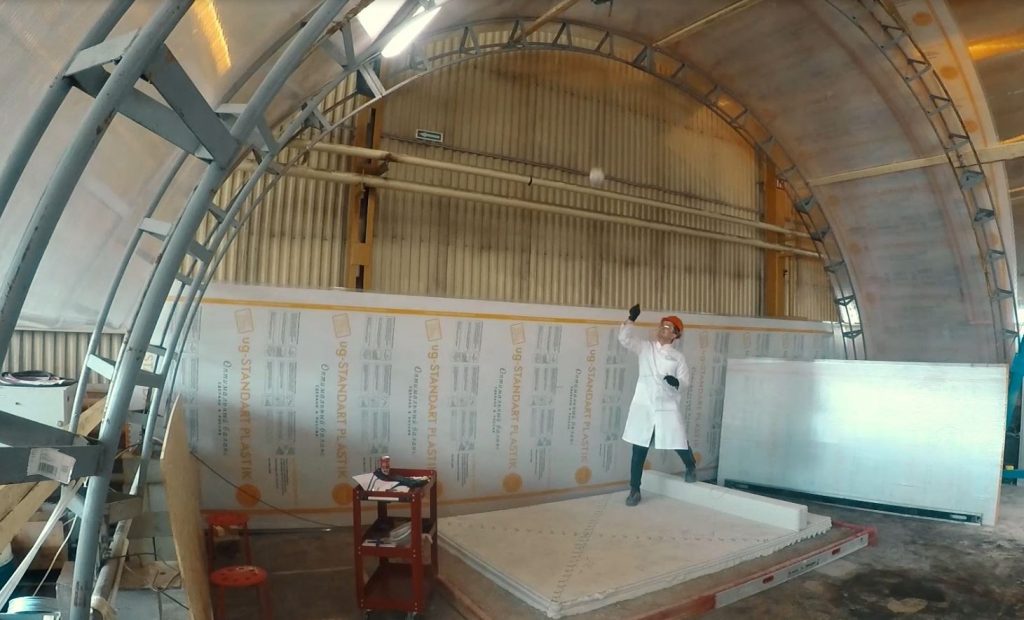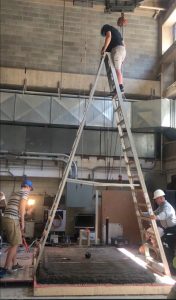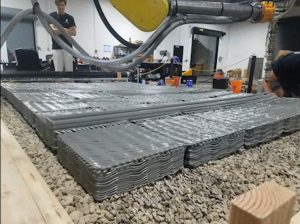The 3D printed slabs were evaluated and scored using multiple criteria like strength, durability and material composition. To test their strength, a standard Olympic shot put was dropped on each slab three times to simulate a meteor strike. To test durability, the slabs were subjected to freeze/thaw tests that simulated the temperature extremes that would be found on Mars.
The winner of this round was Team SEArch+/Apis Cor. SEArch+, or Space Exploration Architecture, is a New York-based firm that has been working for a decade with NASA’s Johnson Space Center Human Habitability Division and Langley Research Center to develop ideas for human habitation on Mars. In 2015, its Mars Ice House concept won first place in Phase 1 of the competition. The beautiful, surreal design relied on 3D printed subsurface ice to create a translucent structure.
Apis Cor is a Russian company that was the first to develop a mobile 3D printer that can print buildings entirely on site. Last year, the company claimed to have 3D printed a house in 24 hours and used multiple advanced technologies to furnish the inside, offering a glimpse of what the homes of the future may look like. The mobile 3D printer was used to print the thick foundation slab required for this level of the competition.
The slab performed well in all of the tests it was subjected to. In a way, this level showed, more than any before, the true potential of 3D printing technology to actually build structures that can stand up to Mars’ harsh conditions.“This level prepares the teams for more difficult levels to come, and they had to do it autonomously, which adds an extra level of difficulty that will be necessary for space exploration,” said Monsi Roman, program manager for NASA’s Centennial Challenges. “Each of the skills tested in these levels will come into play for the final competition next spring.”
Team SEArch+/Apis Cor was awarded $55,154.77 for winning first place in this level of the competition. Second place, with a prize of $32,914.75, went to Pennsylvania State University, while third place and $31,930.48 went to Team FormForge|Austin Industries|WPM. The total amount of prize money for this level was $120,000.
Subsequent levels will involve 3D printing other elements of the habitat; the competition will culminate in 2019 with a final level that requires a one-third scale level 3D print of the entire habitat.
Discuss this and other 3D printing topics at 3DPrintBoard.com or share your thoughts below.
Subscribe to Our Email Newsletter
Stay up-to-date on all the latest news from the 3D printing industry and receive information and offers from third party vendors.
You May Also Like
3D Printing Unpeeled: New Arkema Material for HP, Saddle and Macro MEMS
A new Arkema material for MJF is said to reduce costs per part by up to 25% and have an 85% reusability ratio. HP 3D HR PA 12 S has been...
3D Printing News Briefs, January 20, 2024: FDM, LPBF, Underwater 3D Printer, Racing, & More
We’re starting off with a process certification in today’s 3D Printing News Briefs, and then moving on to research about solute trapping, laser powder bed fusion, and then moving on...
3D Printing Webinar and Event Roundup: December 3, 2023
We’ve got plenty of events and webinars coming up for you this week! Quickparts is having a Manufacturing Roadshow, America Makes is holding a Member Town Hall, Stratafest makes two...
Formnext 2023 Day Three: Slam Dunk
I’m high—high on trade show. I’ve met numerous new faces and reconnected with old friends, creating an absolutely wonderful atmosphere. The excitement is palpable over several emerging developments. The high...


































